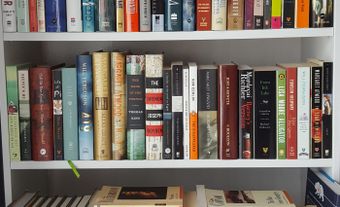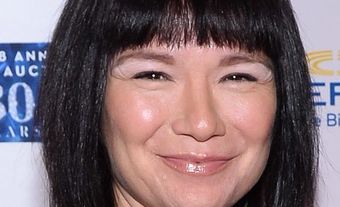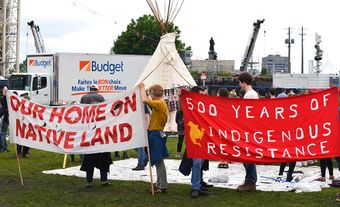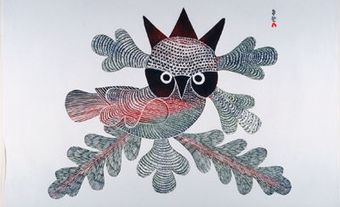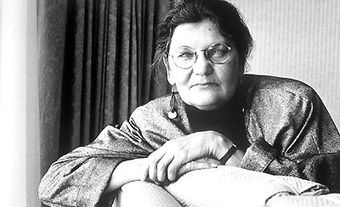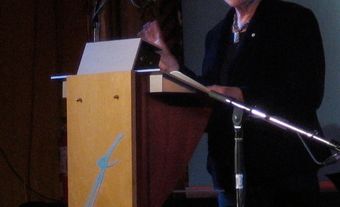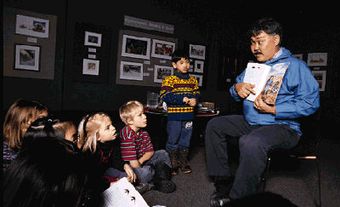Many Indigenous writers in Canada have written books that have made audiences think, laugh, and cry. From fiction to non-fiction, plays to poetry, and more, Indigenous authors have entertained readers in this country and internationally. Rooted in Indigenous culture and history, many of their works are also inspiring, thought-provoking, and urge Canadians to more deeply consider Indigenous people, communities and experiences.
1. Basil H. Johnston (born on 13 July 1929; died 8 September 2015; Anishinaabe)
As a child, Johnston was forced into a residential school where he suffered many abuses. His experience deeply affected some of his works, including Indian School Days (1988). For many Canadians, this autobiography was their introduction to residential schools, many of which, at the time of the book’s publication, were still in existence. While there are moments of levity, the book portrays Johnston’s school as typical of them all in that it was “penitentiary, reformatory, exile, dungeon, whippings, kicks, slaps, all rolled into one.”
Johnston wrote 25 books in English and five in Anishinaabemowin, all urging readers to better understand Indigenous issues and culture.
2. Richard Wagamese (born 14 October 1944; died 10 March 2017; Anishinaabe)
Wagamese and his siblings were raised with white foster care families until, as a teenager, he ran away, ending up homeless and alone. His fiction and non-fiction work reflect his story and the many problems facing Indigenous peoples because of residential schools, the ‘60s Scoop, and socio-economic issues. Wagamese’s books demonstrate the importance of embracing Indigenous traditions as a way forward.
In one of his most well-known books, Indian Horse (2012), the protagonist is brought up in a residential school, but his prodigious hockey talent offers him a way out. Memories of childhood trauma haunt him, however, and sabotage his potential. The book invites readers to grapple with the multi-generational cost Indigenous people continue to pay for systemic racism and residential schools. (See also Intergenerational Trauma and Residential School.)

3. Thomas King(born 24 April 1943; Greek-Cherokee)
King travelled the world and worked at a range of jobs before earning his PhD in 1986 at the University of Utah. He moved to Canada to teach Native Studies at the University of Lethbridge and later at the University of Guelph. He wrote his well-received first novel, Medicine River, in 1990. It was followed by more novels, children’s books, short story collections, films, and works of non-fiction.
King’s The Inconvenient Indian(2012) explores the evolution of the relationship between Indigenous and non-Indigenous peoples in North America, from contact to the 21st century. This important work of non-fiction examines the changing meaning of what it is to be “Indian.” The book is by turns angry, enlightening, and funny, and ends on a note of determined hope.

4. Katherena Vermette (born 29 January 1977; Mennonite-Métis)
Katherena Vermette grew up in Winnipeg’s rough North End. She wrote poetry as a child and later, when working as a kindergarten teacher. Her first book of poetry, North End Love Songs, won the 2013 Governor General’s Literary Award for English Poetry. The poems in this book contrast the beauty of the birds and trees in Winnipeg’s North End with the challenges of holding families and friendships together when surrounded by crime and drugs. Systemic racism is revealed when a brother goes missing and, because he is Indigenous, neither the media nor police seem to care. Vermette’s use of spare language to relay deep emotion and celebrate unwavering resilience is moving and effective.
She has since published more poetry, short stories, and made films. Her first novel, The Break, was nominated for a 2017 Governor General’s Literary Award and was a Canada Reads finalist. In 2021, Vermette received the Atwood Gibson Writers' Trust Fiction Prize for her novel, The Strangers.

5. Drew Hayden Taylor (born 1 July 1962; Anishinaabe)
Taylor is a storyteller and playwright and has served as artistic director of the Native Earth Performing Art company. He has written television scripts and plays that have been performed around the world. Taylor has also written over 30 fiction and non-fiction books that have questioned, informed, and challenged readers about what it means to be Indigenous. (See also Theatre by Indigenous Peoples in Canada.)
In one of his most well-known books, Motorcycles and Sweetgrass (2010), the main character Maggie struggles to be a responsible mother and chief of her community. She falls in love with a suspicious white stranger who arrived on an old Indian Chief motorcycle. Political, religious, cultural, and historical themes are interwoven as characters address personal challenges and their desire for better lives. As is typical for Taylor’s work, however, humour is never far away.

6. John Borrows (born 1963; Anishinaabe)
Borrows is an internationally respected University of Victoria law professor and storyteller. His books address constitutional law and Indigenous traditions and legal rights. Borrows has contributed to a better understanding of land claims, treaty rights, and environmental law. Among his many awards is an Aboriginal Achievement Award (now Indspire) in Law and Justice and he was named a Fellow of the Academy of Arts, Humanities, and Sciences of Canada. In 2020 he was made an officer in the Order of Canada and won the 2020 Best Book award from Native American and Indigenous Studies Association for “Law’s Indigenous Ethics”.
Borrow’s book, Canada’s Indigenous Constitution (2010), argues that Canada’s system of common and civil law does not respect its constitutional foundations and so does not guarantee Indigenous legal equality. To remedy this situation and move toward reconciliation, he writes, Indigenous legal traditions must be recognized as the third arm of Canadian law along with common and civil law. In this way, western and Indigenous legal traditions and practices can co-exist within revamped public institutions.

7. Lee Maracle (born 2 July 1950; died 2 November 2021;Métis and Stó:lō)
Maracle grew up in North Vancouver and became a stand-up comedian and film maker before becoming one of the most prolific writers in Canada. Her poetry, short stories, novels, non-fiction, and collaborative anthologies address a range of Indigenous issues but focus on the liberation of Indigenous women as a key to decolonization and fundamental progress. (See also Indigenous Women’s Issues in Canada.)
In Ravensong (1993), a novel is set in the 1950s, the colonizer arrives as a flu epidemic and shifts traditional power in an urban Pacific Northwest Indigenous community. As traditions are attacked, women are robbed of their dignity and agency. A teenage girl and her sister fight back by seeking solace in and direction from their cultural heritage. Raven warns of impending doom caused by the clash of the two cultures.
Maracle was a passionate activist and educator. In the fall of 2021, she joined the faculty of Kwantlen Polytechnic University in British Columbia as a teacher in Indigenous Studies.
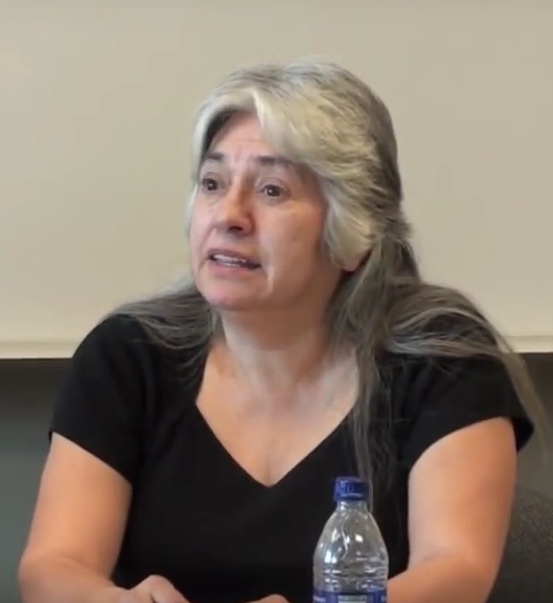
8. Cherie Dimaline (born 2 July 1975; Métis)
Dimaline grew up in a family within a Georgian Bay Métis community that celebrated storytelling. Her novels and short story collections for young adults engage readers while respecting their ability to wrestle with complex and difficult issues. Her books have won numerous awards and international attention. Dimaline has also promoted a better understanding of Indigenous issues as a magazine editor and as an editor at Theytus Books, the oldest Indigenous publishing house in Canada.
Dimaline’s well-known novel The Marrow Thieves (2017) presents a dystopian future in which people have lost their ability to dream. The only solution is to hunt Indigenous people to harvest their bone marrow. Frenchie and his friends return to the land to survive. The novel won the Governor General's Literary Award for Young People's Literature and was a finalist on CBC’s Canada Reads.
9. Tomson Highway (born 6 December 1951; Cree)
After graduating university, Tomson became a social worker in Indigenous communities. His writing career began as a playwright and he went on to create novels, children’s books, and songs. All speak bluntly of tragedies endured by Indigenous peoples and of the resilience found in humour and stubborn optimism. Maclean's magazine once listed Tomson as one of the 100 most important people in Canadian history.
In his memoir, Permanent Astonishment(2021), Highway traces his life, from growing up in rural Manitoba and suffering residential school to finding solace in traditional ways. It sparkles with the indominable spirit of adolescence that blends confidence, fear, and daring. The best-selling book won the prestigious Hilary Weston Writers' Trust Prize for Nonfiction.

10. Markoosie Patsauq (born 24 May 1941, died 8 March 2020; Inuk)
Born on the eastern coast of Hudson Bay, Patsauq had a traditional Inuit upbringing. At the age of 12, his family was forced to move to Resolute. Patsauq later spoke about the difficulty in finding food on land that was unknown to them. (See also High Arctic Inuit Relocations in Canada.) At 17, he was sent to Yellowknife to attend residential school. He grew up to become a writer and activist. Patsauq was instrumental in the movement to create the territory of Nunavut and in getting the federal government to apologize for the High Arctic relocations.
His novel, Harpoon of the Hunter, was released in Inuktitut in 1969. It is considered the first published Inuit novel. (Mitiarjuk Nappaaluk’s novel Saanaq, written in the 1950s but published in 1984, is also among the first Inuktitut novels.) Harpoon of the Hunter was later translated into English and many other languages. This book tells a story from four points a view and offers insight into Inuit cultures and communities. Patsauq died shortly before the novel’s re-release, which featured a new translation and title, Hunter With Harpoon.

 Share on Facebook
Share on Facebook Share on X
Share on X Share by Email
Share by Email Share on Google Classroom
Share on Google Classroom
